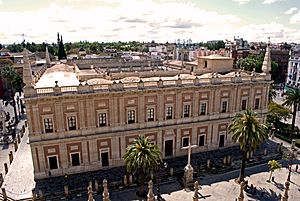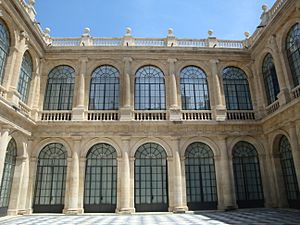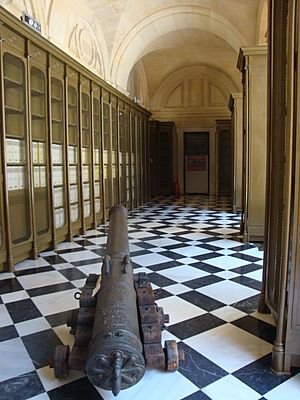General Archive of the Indies facts for kids
Quick facts for kids General Archive of the Indies |
|
|---|---|
| Native name Spanish: Archivo General de Indias |
|

The Archivo de Indias, Seville
|
|
| Location | Seville, Andalusia, Spain |
| Built | 16th century |
| Architect | Juan de Herrera Juan de Mijares |
| Architectural style(s) | Renaissance |
| Official name: Cathedral, Alcázar and Archivo de Indias in Seville | |
| Type | Cultural |
| Criteria | i, ii, iii, vi |
| Designated | 1987 (118th session) |
| Reference no. | 383 |
| Region | Europe |
| Lua error in Module:Location_map at line 420: attempt to index field 'wikibase' (a nil value). | |
The General Archive of the Indies (also known as the Archivo General de Indias) is a very important building in Seville, Spain. It holds many valuable old documents. These documents tell the story of the Spanish Empire in places like the Americas and Asia. The building itself is a beautiful example of Renaissance architecture. It was designed by Juan de Herrera. In 1987, UNESCO named this building a World Heritage Site. It shares this honor with the nearby Seville Cathedral and the Alcázar of Seville.
The Building's Story
The idea for this building started in 1572. King Philip II asked Juan de Herrera to design it. Herrera was also the architect of the famous Escorial palace. The building was meant to be a place for merchants in Seville to do business. Before this, they often met inside the cool Seville Cathedral.
Construction of the building, called the Lonja, began in 1584. Juan de Mijares followed Herrera's plans. The first parts of the ground floor were finished by 1598. The rest of the ground floor was done the next year. Work on the upper levels paused in 1601 because of money problems. It started again in 1609 but the building was not fully finished until 1646.
The building has a large central courtyard. It has two floors with many windows. The design is simple and elegant, using different shades of stone. There are no fancy statues, just clean lines and shadows.
After a terrible plague in 1649, merchants stopped using the building. From 1660 to 1674, one room was even used as a painting school. The famous artist Bartolomé Esteban Murillo started this school. By the 1700s, the top floor was divided into apartments.
Why the Archive Was Created
In 1784, a historian named Juan Bautista Muñoz had an idea. He was trying to write a history of the New World (the Americas). He suggested creating one central place for all documents about the Americas. He wrote to José de Gálvez, who was a minister for the Indies. Gálvez liked the idea and told Muñoz to look for a suitable building in Seville.
Muñoz visited the old Lonja building in May 1784. He was very excited about it. He wrote to Gálvez that it was a strong stone building with plenty of space. He said they would just need to remove the new walls on the upper floor.
King Charles III approved the plan in 1784. In 1785, he officially ordered the creation of the archive. The goal was to bring together all documents about Spain's overseas empire. These papers were scattered in different archives, like Simancas and Cádiz.
One reason for this project was that the main Spanish archive in Simancas was running out of space. Also, during the Age of Enlightenment, there was a desire for Spanish historians to write about their colonial empire. The first documents arrived at the Casa Lonja in October 1785. A grand marble staircase was added in 1787 to help move the many documents.
What's Inside the Archive
The General Archive of the Indies holds an amazing collection of historical papers. You can find original writings from the first Conquistadores (Spanish explorers and conquerors). The documents go all the way up to the late 1800s.
Some famous items include:
- A request from Miguel de Cervantes (who wrote Don Quixote) for an official job.
- The Inter caetera document from Pope Alexander VI. This paper divided the world between Spain and Portugal.
- The journal of Christopher Columbus.
- Old maps and plans of colonial American cities.
Today, the archive has about nine kilometers (over 5.5 miles) of shelves. It holds 43,000 volumes and around 80 million pages! These documents were created by the colonial government. Some of the main collections come from:
- The Consejo de Indias (Council of the Indies), from the 16th to 19th centuries.
- The Casa de la Contratación (House of Trade), from the 16th to 18th centuries.
- Various government departments that managed trade, justice, and finance.
The building was carefully restored between 2002 and 2004. It continued to work as a research library during this time. As of 2005, 15 million pages were being scanned into digital format. These digital documents can be accessed online.
See also
 In Spanish: Archivo General de Indias para niños
In Spanish: Archivo General de Indias para niños



